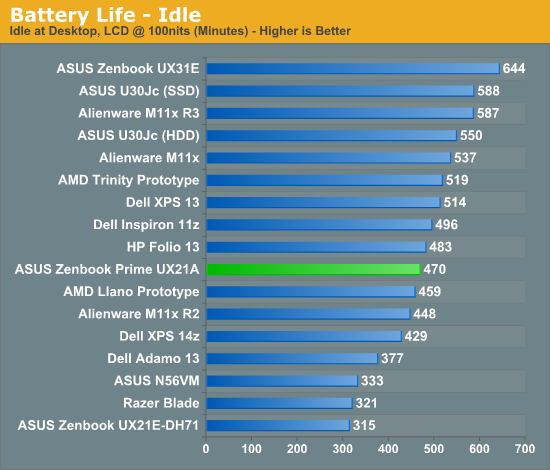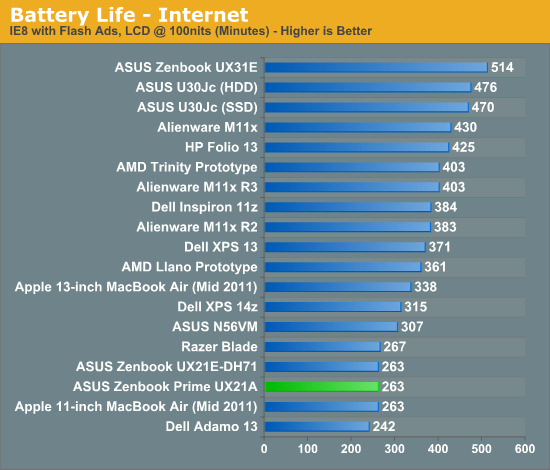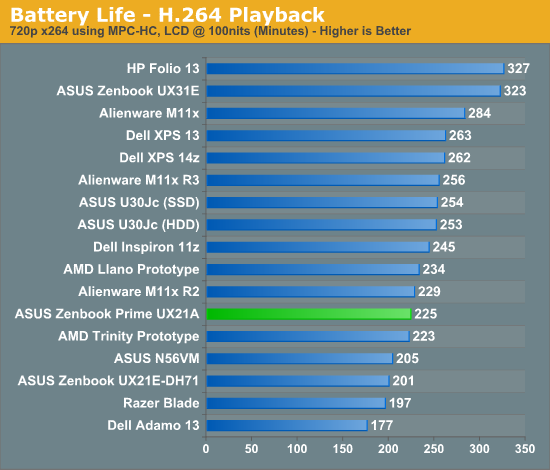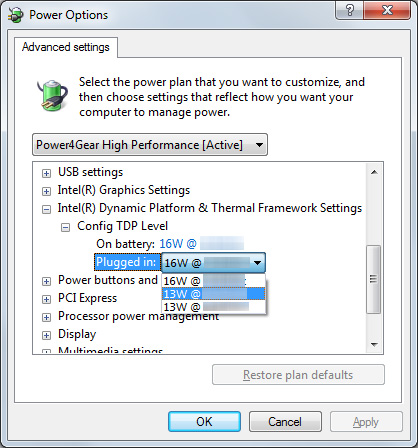ASUS Zenbook Prime (UX21A) Review: The First of the 2nd Gen Ultrabooks
by Anand Lal Shimpi on May 22, 2012 2:46 PM EST- Posted in
- Laptops
- CPUs
- Asus
- Ivy Bridge
- Zenbook
- Zenbook Prime
- Ultrabook
- Notebooks
Battery Life
Generally speaking, the 11-inch Zenbook Prime delivers about the same amount of battery life as its predecessor. For some reason we're able to hit much longer idle battery life on the Prime than the original Zenbook although I'm still trying to find out why. There's also an 11% improvement in our x264 playback test, but on average I'd expect to see similar battery life to the Sandy Bridge model - just with better performance. Note that these results also come despite the fact that ASUS is driving a much higher resolution, and presumably higher power, display than the original Zenbook.



The Zenbook Prime bucks the trend Jarred saw with the first Ivy Bridge notebook review where battery life took a small step backwards. These results bode well for future Ivy Bridge notebooks and Ultrabooks. It still remains to be seen if Intel's 22nm process will actually give us a battery life advantage in any notebook compared to its predecessor. It's possible that we are seeing some of the benefits of 22nm here already and they are simply offset by the more power hungry display. With the move to 22nm Intel should have a better hold on active power and leakage, but it's always possible that we'll have to wait until Haswell for the process to really be exploited.
Just like last time, ASUS has a couple of widgets to quickly change between power settings. The instant on widget lets you switch between suspend to RAM and suspend to disk modes. The former is expected to deliver up to 2 weeks of standby battery life, while the latter can push up to 150 days. I didn't have the time to test these claims (life is short, I draw the line at spending it testing claims of 150 day standby battery life). ASUS once again includes a counter that estimates how long your system will last in either mode based on current charge levels and power usage.
The next widget is a quick tool to let you switch between high performance and battery saver Power4Gear power profiles. You can customize these profiles via the Windows control panel, but it's nice to have a button on the desktop that lets you quickly switch between them.
Configurable TDP
One feature of Ivy Bridge that we haven't been able to test until now is configurable TDP. While most Ultrabook CPUs ship with a 17W TDP, that's mostly an arbitrary thermal/power rating. If an OEM wants to design a chassis that can only accept a 13W part it previously had to hope that Intel would make such a thing. Alternatively, the OEM could underclock/undervolt a 17W chip on their own and hope to mimic Intel's validation and deliver a 13W configuration of their own. The former requires that a significant number of OEMs demand the part, while the latter is just too risky for the larger OEMs (get too aggressive on the undervolting side and end up with a bunch of unstable systems). The solution Intel proposed with Ivy Bridge is configurable TDP. For Ultrabooks this means you can set a 17W part to 13W.

Currently the setting is hidden away in Windows 7's power management settings. Once again I've had to censor the clock speeds here due to Intel's Ultrabook embargo:
You can map the 13W settings to the battery saver profile and then, at the click of a button, have a 13W Zenbook Prime instead of a 17W model. The difference in performance isn't significant however:
| ASUS Zenbook Prime Configurable TDP Performance - Cinebench 11.5 (Multithreaded) | |||||||
| 16W - Max Freq | 13W - Mid Freq | 13W - Lowest Freq | |||||
| ASUS Zenbook Prime UX21A | 2.79 | 2.67 | 2.67 | ||||
I'm still running battery life tests to quantify the impact on power consumption, but it's conceptually a neat thing to see in action finally. I suspect configurable TDP is going to play a major role with Haswell and convertible/dockable Ultrabook-tablet hybrids.
Thermals and Noise
As with most high performance notebooks that are this thin, cooling is difficult. Under load the fans in the Zenbook Prime are definitely audible, but in general ASUS does a better job cooling everything inside the Zenbook Prime than Apple does in the MacBook Air. I suspect much of this boils down to how aggressive Apple is about keeping fan speed/noise down compared to ASUS' desire to maintain a certain temperature level inside the chassis.










192 Comments
View All Comments
Pneumothorax - Tuesday, May 22, 2012 - link
Finally,my days of running bootcamp on a MBA are coming to an end!g1011999 - Wednesday, May 23, 2012 - link
Beginning of new retina display MBA?Endeavour1934 - Tuesday, May 22, 2012 - link
2 years ago when Sony first released the VAIO Z with the 1920x1080 display, they said that because the grid of pixels was more dense, it needed 25% more backlight power than the 1600x900 version in order to have the same level of brightness.Maybe the same thing happens with this new IPS display, and that may be one of the reasons why the battery life is not better than the previous generation.
saneblane - Tuesday, May 22, 2012 - link
I've yet to see what's so ultra about this. The performance is not their, the gpu sucks and they are not Apple to be selling things with not much use. Good luck with this.CaioRearte - Tuesday, May 22, 2012 - link
Sorry Intel, but it seems AMD won the slim-notebook round. Intel can't catch up on video performance at this wattage, and tons of processing power aren't exactly what a laptop owner is looking for. Since AMD has been turning towards diverse computing methods for a while, and actively dedicating more to the graphics than to raw power, their products will be more balanced and enticing in the long run.Anyway, the UX32 with the dedicated 620M looks like a good contender, when are you getting your hands on it? :)
Lilian_Anne32 - Tuesday, May 22, 2012 - link
I have the previous version of this which I bought a few months ago.... it didn't have a backlit keyboard or anything else I expected it to have, with the keyboard being annoying and all, but the laptop functions well. I was just curious if the first models are tradeable for a newer model?That extra USB port would be very useful for me right now.
TrackSmart - Tuesday, May 22, 2012 - link
Well, you certainly won't be able to trade in the older model, but you could easily sell it on Ebay when the new one comes out. If you are talking about replacing your keyboard for the backlit keyboard on the new one, I wouldn't count on it. It sounds like it has been substantially redesigned.On the plus side, you'll have enjoyed your new laptop for have a year by the time the new model comes out. There will always be a better model coming out in 6 months. Enjoy what you've got.
IntelUser2000 - Tuesday, May 22, 2012 - link
I think the improvement in battery life can be attributed to the following:-USB 3.0 controller moving from a dedicated chip to a integrated one in the HM7x PCH
-Improved software/hardware build quality. Also maybe the Sandisk SSD offers bettery battery life?
-DDR3L memory? Ivy Bridge allows DDR3L support, and I've also read that the new Zenbook uses one
kenyee - Tuesday, May 22, 2012 - link
I know it's a copy of the Macbook Air, but 4GB isn't enough for people running VMs. And you know Apple is going to increase their memory limit with the next release ;-)Love the screen though...about time they started putting high density screens in these things...
theknowhow - Tuesday, May 22, 2012 - link
Confused on the configuration versus the price on UX32.As far as I can see, the $799 vs. $ 999 device differs only in additional HDD. I would have made sense if its an SSD difference
Am I missing something here?